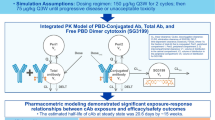Abstract
Purpose
Characterize the population PK and exposure–response (ER) relationships of selinexor in patients with diffuse large B-cell lymphoma (DLBCL) (efficacy endpoints) or other non-Hodgkin’s lymphoma (NHL) patients (safety endpoints) to determine the optimal dose in patients with DLBCL.
Methods
This work included patients from seven clinical studies, with 800 patients for PK, 175 patients for efficacy and 322 patients for safety analyses. Logistic regression models and Cox-regression models were used for binary and time-to-event endpoints, respectively. Model-based simulations were performed to justify dose based on balance between efficacy and safety outcome.
Results
Selinexor pharmacokinetics were well-described by a two-compartment model with body weight as a significant covariate on clearance and central volume of distribution and gender on clearance. Overall response rate (ORR) in patients with DLBCL increased with day 1 Cmax and decreased in patients with higher baseline tumor size (p < 0.05). Significant exposure–safety relationships (p < 0.05) in NHL patients were identified for the frequency of the following safety endpoints: dose modifications, decreased appetite Grade ≥ 3 (Gr3+), fatigue Gr2+, vision blurred Gr1+, and vomiting Gr2+. Similar exposure–safety relationships were found for time-to-onset of the adverse events.
Conclusions
Simulations of the safety and efficacy ER models suggested that, compared to a starting dose of 60 mg twice weekly (BIW), a 40 mg BIW regimen resulted in an absolute decrease in AE probabilities between 1.9 and 5.3%, with a clinically significant absolute efficacy decrease of 4.7% in ORR. The modeling results support that 60 mg BIW is the optimal dose in patients with DLBCL.



Similar content being viewed by others
References
Tan DSP, Bedard PL, Kuruvilla J, Siu LL, Razak AR (2014) Promising SINEs for embargoing nuclear-cytoplasmic export as an anticancer strategy. Cancer Discov 4(5):527–537
Gravina GL, Senapedis W, McCauley D, Baloglu E, Shacham S, Festuccia C (2014) Nucleo-cytoplasmic transport as a therapeutic target of cancer. J Hematol Oncol 7(1):85
Jagannath S, Vogl DT, Dimopoulos M-A, Nooka A, Huff C, Moreau P et al (2018) Phase 2b results of the STORM study: oral selinexor plus low dose dexamethasone (Sd) in patients with penta-refractory myeloma (penta-MM). Clin Lymphoma Myeloma Leuk 18(S1):S249–S250
Chari A, Vogl DT, Gavriatopoulou M, Nooka AK, Yee AJ, Huff CA et al (2019) Oral selinexor-dexamethasone for triple-class refractory multiple myeloma. N Engl J Med 381(8):727–738
Kalakonda N, Maerevoet M, Cavallo F, Follows G, Goy A, Vermaat JSP et al (2020) Selinexor in patients with relapsed or refractory diffuse large B-cell lymphoma (SADAL): a single-arm, multinational, multicentre, open-label, phase 2 trial. Lancet Haematol 7(7):e511–e522
Garzon R, Savona M, Baz R, Andreeff M, Gabrail N, Gutierrez M et al (2017) A phase 1 clinical trial of single-agent selinexor in acute myeloid leukemia. Blood 129(24):3165–3174
Bader JC, Abdul Razak AR, Shacham S, Xu H (2021) Pharmacokinetics of selinexor: the first-in-class selective inhibitor of nuclear export. Clin Pharmacok J
Bergstrand M, Karlsson M (2009) Handling data below the limit of quantification in mixed effect models. AAPS J 11(2):371–380
Jonsson EN, Karlsson MO (1998) Automated covariate model building within NONMEM. Pharm Res 15(9):1463–1468
Bergstrand M, Hooker AC, Wallin JE, Karlsson MO (2011) Prediction-corrected visual predictive checks for diagnosing nonlinear mixed-effects models. AAPS J 13(2):143–151
R Core Team (2016) R: a language and environment for statistical computing. Vienna, Austria: R Foundation for Statistical Computing. https://www.R-project.org/
Calvier EA, Krekels EH, Välitalo PA, Rostami-Hodjegan A, Tibboel D, Danhof M et al (2017) Allometric scaling of clearance in paediatric patients: when does the magic of 0.75 fade? Clin Pharmacokinet 56(3):273–285
Crochiere ML, Hannus S, Hansen K, Becker F, Baloglu E, Klebanov B et al (2017) XPO1 target occupancy measurements confirm the selinexor recommended phase 2 dose. Oncotarget 8(66):110503–110516
Crochiere ML, Baloglu E, Klebanov B, Donovan S, Del Alamo D, Lee M et al (2016) A method for quantification of exportin-1 (XPO1) occupancy by Selective Inhibitor of Nuclear Export (SINE) compounds. Oncotarget 7(2):1863–1877
Liston DR, Davis M (2017) Clinically relevant concentrations of anticancer drugs: a guide for nonclinical studies. Clin Cancer Res 23(14):3489–3498
Author information
Authors and Affiliations
Corresponding author
Ethics declarations
Conflicts of interest
H. Xu, J.C. Bader, S. Tang, J. Shah, and S. Shacham are employees for Karyopharm Therapeutics. H. Li and R. Wada are employees of Certara and were paid consultants for Karyopharm Therapeutics for the analyses described herein.
Additional information
Publisher's Note
Springer Nature remains neutral with regard to jurisdictional claims in published maps and institutional affiliations.
Supplementary Information
Below is the link to the electronic supplementary material.
Rights and permissions
About this article
Cite this article
Xu, H., Li, H., Wada, R. et al. Selinexor population pharmacokinetic and exposure–response analyses to support dose optimization in patients with diffuse large B-cell lymphoma. Cancer Chemother Pharmacol 88, 69–79 (2021). https://doi.org/10.1007/s00280-021-04258-6
Received:
Accepted:
Published:
Issue Date:
DOI: https://doi.org/10.1007/s00280-021-04258-6




